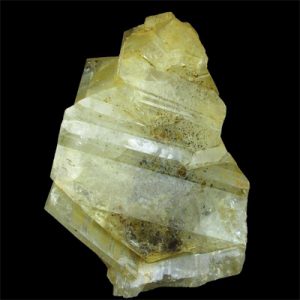Hyalophane (Feldspar)
Hyalophane or jaloallofane is a crystalline mineral, part of the feldspar group of tectosilicates. It is considered a barium-rich potassium feldspar.[5] Its chemical formula is (K, Ba)[Al(Si, Al)Si2O8], and it has a hardness of 6 – 6 1⁄2. The name hyalophane comes from the Greek hyalos, meaning “glass”, and phanos meaning “to appear”. An occurrence of hyalophane was discovered in 1855 in Lengenbach Quarry, Imfield, Binn valley, municipality of Binn, Canton of Valais, Switzerland. The mineral is found predominantly in Europe, with occurrences in Switzerland, Australia, Bosnia, Germany, Japan, New Jersey, and the west coast of North America. Hyalophane may be found in manganese deposits in compact metamorphic zones
Hyalophane has a monoclinic crystallography, with cell properties a = 8.52 Å, b = 12.95 Å, c = 7.14 Å, and β = 116°. Optically, the material exhibits biaxial birefringence, with refractive index values of nα = 1.542, nβ = 1.545, and nγ = 1.547 and a maximum birefringence of δ = 0.005. It has weak dispersion and low surface relief. Hyalophane has sometimes been used as a gemstone. Hyalophane is very gemstone that is uncommon a known member regarding the Feldspar band of minerals which also contains Albite, Amazonite, Andesine, Anorthite, Bytownite, Hyalophane, Labradorite, Moonstone, Oligoclase, Orthoclase, Sanidine, and Sunstone. It is always found as translucent to opaque crystals of colorless, pale or yellow that is white. Crystals are rarely found clean enough for faceting.The source that is is current of rare crystals is Busovaca, Bosnia.
| Category: | Tectosilicate | |
| Formula: | (K,Ba)[Al(Si,Al)Si2O8] | |
| Crystallography: | Monoclinic – Prismatic | |
| Crystal Habit: | Crystals similar to Adularia or Orthoclase, to 20 cm; also granular or massive. | |
| Twinning: | Commonly simple twins according to the Carlsbad, Manebach, or Baveno laws. | |
| Cleavage: | [001] Perfect, [010] Imperfect |
| Fracture: | Uneven, Conchoidal |
| Tenacity: | Brittle |
| Hardness (Mohs): | 6.0 – 6.5 |
| Density: | 2.58 – 2.82 (g/cm3) |
| Luminescence: | None |
| Radioactivity: | Barely Detectable, GRapi = 9.71 (Gamma Ray American Petroleum Institute Units) |
| Color: | Colorless, White, pale Yellow, Red |
| Transparency: | Transparent to Translucent |
| Luster: | Vitreous |
| Refractive Index: | 1.542 – 1.547 Biaxial ( – ) |
| Birefringence: | 0.005 |
| Dispersion: | Weak; r > v |
| Pleochroism: | None |


